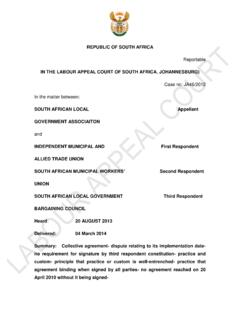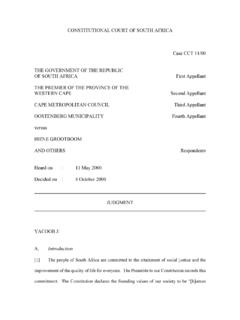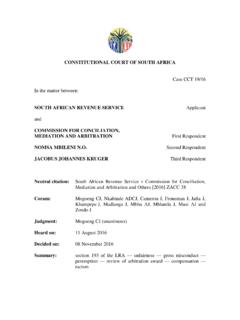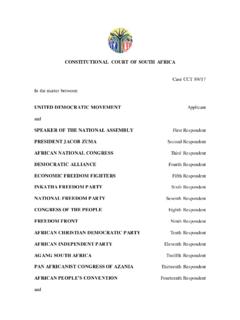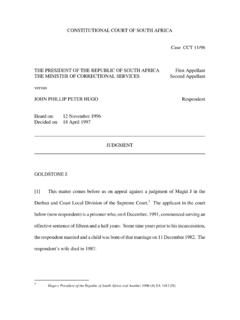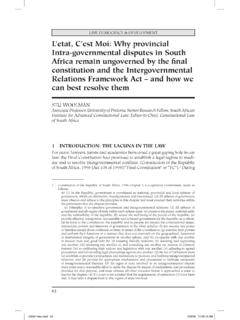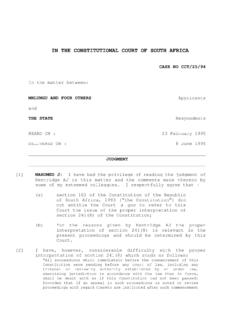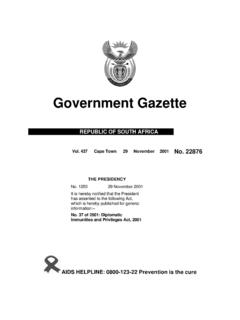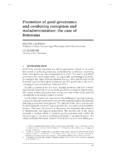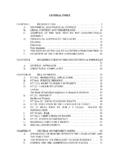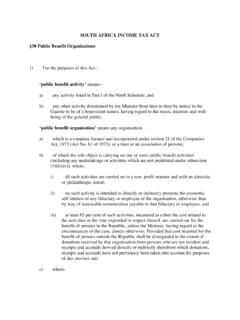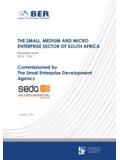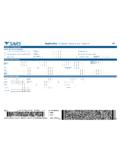Transcription of IN THE HIGH COURT OF SOUTH AFRICA EASTERN CAPE …
1 1 IN THE HIGH COURT OF SOUTH AFRICA EASTERN CAPE LOCAL DIVISION: MTHATHA CASE NO. 4062/2016 In the matter between: VUYISILE ZAMINDLELA NONDABULA Applicant and THE COMMISSIONER: SARS & ANOTHER Respondents JUDGMENT JOLWANA AJ: [1] The applicant brought an application interdicting the first respondent from invoking the provisions of section 179 of the Tax Administration Act of 2011, the Act , pending the final determination of the applicant s objection to the additional assessment of his income tax.
2 The applicant further sought an order withdrawing a Third Party Notice that had been issued in terms of the Act and other ancillary relief. 2 [2] The applicant is a business man and sole proprietor of a fuel service station called Umzimkhulu Shell Garage and it is in respect of this business that he is liable to pay taxes to the first respondent in these proceedings. [3] The first respondent issued an income tax assessment against the applicant for the 2013/2014 financial year in terms of which the applicant owed tax to the first respondent in an amount of R17 807 84.
3 The first respondent issued an Income Tax Notice of Assessment reflecting the said amount as the outstanding tax debt for which the applicant was liable to pay on or before the 31st July 2014. The applicant duly paid this amount. The first respondent issued another assessment dated 31st October 2015 for the financial year 2014/2015 in terms of which the applicant owed tax debt of R15 768 69. This amount was also paid timeously. Up to this point the relationship between the applicant and the first respondent appears to have been cordial with assessments being issued and the assessed taxed debt being paid on time.
4 [4] The problem which resulted in these proceedings started when the first respondent acting within its power and authority, issued another assessment in terms of which the applicant owed the first respondent R1 422 637-83. This was brought to applicant s attention by means of a letter dated 29 September 2016 which in part reads as follows: According to the records of the SOUTH African Revenue Service (SARS) you have failed to pay the following amounts: Income Tax Debt Totalling R1 422 637-83 which is made up of the following amount(s) R1 422 637-83 for Assessed Tax.
5 This notification demanded that this amount be paid within 10 days failing which further action would be taken. This notification had, about two weeks 3 earlier, been preceded by a statement of account issued by the first respondent which reflected a balance brought forward in the sum of R1 404 517-97. This in turn was preceded by a letter dated 11 May 2016 which was a final demand by the first respondent, in terms of which applicant was required to pay R1 424 690-79 within 10 days. [5] The only real attempt by the first respondent to explain how these amounts came about seems to have been the statement of account issued by the first respondent dated 4th April 2016 which reflects an additional assessment for 2014 in the sum of R1 240 455-94 as at 1 March 2016.
6 How this figure or any of the other figures said to be owing are arrived at does not seem to have been explained to the applicant. [6] Even in the affidavit filed on behalf of the first respondent there is no attempt to give a breakdown of how these amounts or any of them are arrived at. The applicant challenges the first respondent about his ignorance of how this amount is arrived at as follows: I did not know how the first respondent reached this amount or what information informed it to reach that amount. I was certainly not consulted or confronted with any information that first respondent could have come across that would make it to reach that amount after the same first respondent sent me an ITA34 Form (Notice of Assessment) for the 2014 tax year, and on which I paid the outstanding tax then, as stated above in par 20, per Annexure E.
7 [7] The first respondent responded as follows to this challenge at paragraph 21 of its answering affidavit: 4 The allegations contained in paragraph 33 are bad in law. The basis for the first respondent s decision, in any case, to impose an additional assessments upon a tax payer is as described above. Same does not require consultation and/or agreement with the taxpayer. For this reason, I deny these allegations. [8] Nowhere in the answering affidavit does the first respondent claim to have furnished a breakdown to the applicant.
8 Even in the papers filed and during argument no contention was advanced on behalf of the first respondent that the applicant knew or ought to have known how the first respondent calculated this additional assessment. [9] The applicant objected to the additional assessment through his accountants on the 4th of April 2016. The first respondent responded to this objection by objecting to the objection on the basis that the applicant s abjection does not comply with the rules in that a request for waiver of penalties and a dispute against income cannot be submitted on the same objection.
9 This response is dated 5 May 2016. [10] On the 3 June 2016 applicant s accountants wrote another letter to the first respondent in which further documentation was submitted and a request was made for the first respondent to reconsider the assessment and note the objection. This objection was preceded by another objection filed through the first respondent s e-filing system. All these objections were not responded to and even where there was a response it was not a substantive response but an objection to the applicant s objection.
10 Communication was exchanged between the parties but at no stage did the first respondent attempt to justify the amount 5 claimed through some form of a breakdown. The first respondent contented itself with raising its own technical objection to the applicant s objections. [11] The first respondent is a creature of statute and as such it must operate within the four corners of the statutory provisions which empower it. The first respondent is governed by and operates in terms of the Act. It therefore cannot do anything not specifically provided for in the Act or some other legislation nor can it conduct itself contrary to the provisions of the Act.
